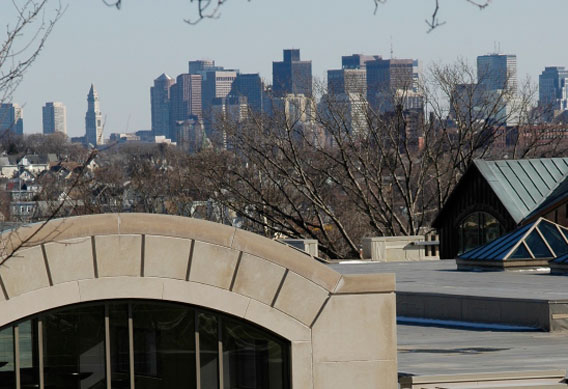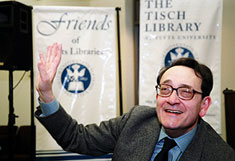Parting View from the Hill
Felipe Fernández-Armesto takes a farewell look from the Tufts campus
By Felipe Fernández-Armesto
Editor’s Note: Felipe Fernández-Armesto was the Prince of Asturias Professor of History. The fall 2008 semester was his last at Tufts before he returned to his home in London. He writes a regular column for the Times Higher Education supplement, and in December penned this paean to Tufts University, his home for the past four years.
I can remember when Oxford freshmen arrived at the station to be greeted by a sign that put them in their place: “Oxford,” it proclaimed, “The Home of Pressed Steel.” You can’t define the character of a university without looking outside it, at the neighborhood or landscape that surrounds it and helps to shape it, menacingly or embracingly.

“From the roof of the university library, the city looks domesticable—almost part of Tufts’ domain,” says Felipe Fernández-Armesto. Photo: Brian Loeb, A06
Almost all the universities I know well are urban, deeply affected by the contrasts or continuities that fend off or fuse their environs. I can’t think of Oxford without the canalside or Cowley, or Columbia without Harlem, or Yale without the encroaching decay of industrial New Haven, or Harvard without the soigné riverbank the university colonized in the 1930s, or the University of Chicago without the black ghetto, now bleakly gentrified, that used to lap its ivy-clung quadrangles.
The University of Edinburgh is a spark of Enlightenment, igniting the crest of the old town like a beacon. Queen Mary, where I used to work, is alight with reflections of the immigrant communities that have colonized its East End environment. The old Sephardic burial ground is in the heart of the college. Muslim migrants enliven the university corridors and surrounding streets. Brown University, where I was once a visiting professor, blends into the brickwork grid of colonial streets that separate it from Providence’s river and the tough, towering Mafia-haunted downtown.
Tufts University, where I now work, was once in a poor neighborhood. Somerville, where I live, was known as “Slummerville” by the Harvard high-rollers until the decline of academic incomes forced Harvard professors to live here. Now the environs have lost any distinctive character and have become just another characteristically crammed suburban Boston neighborhood of disproportionately big, wood-framed houses on diminutive, rock-ribbed plots, where half-hearted gardens fight a losing battle with the extremes of the climate.
Today, Tufts is defined by the view from its hilltop campus, which spreads the Boston skyline at the beholder’s feet, affording one of life’s rare opportunities to look down on Bostonians, who tend to be unbearably superior. When Dickens visited the city in 1842, he got involved in a conversation about Shakespeare. “Sir,” his interlocutor assured him, “Shakespeare was a very great man. I doubt whether there are 50 his equal in the whole of Boston.”

Felipe Fernández-Armesto at a 2008 Friends of the Tufts Libraries lecture. Photo: J.D. Sloan
From the roof of the university library, the city looks domesticable—almost part of Tufts’ domain. When I first came here to see whether I wanted the job, and whether the university wanted me, I felt like Christ on Tibidabo, with Mammon at my elbow whispering, “All this will I give thee if thou wilt bow down and worship me.” So, unlike Christ, I did.
The only other university I know where the view has done so much to shape the character of the place is Georgetown, the oldest Catholic university in the United States, which occupies the loftiest hilltop in Washington, D.C. Every time I go there I contemplate the relationship with satisfaction. From its grand eminence, the Church can despise the State, and academia can soar above politics. The founding fathers who created a secular constitution must have gnashed their teeth when they looked up from their dank, marshy site and saw how the clergy had snaffled the best real estate. What Georgetown is to Washington, Tufts is to Boston.
Tufts, too, has a religious foundation, if you count Unitarian Universalists as religious. No formal link with the church survives. Uniquely among non-Catholic institutions in the U.S., Tufts has a Catholic university chaplain. There is a big cohort of Jewish students. One of the most recent additions to the campus is a multifaith center.
Paradoxically, in this determined pluralism, the Universalist ethos survives. The university’s distinct profile is as a place where students are encouraged to think globally. There are programs in global literacy, global education, global health, global history and almost anything that can reasonably be qualified with the same epithet. Every year, on United Nations Day, we run down the Stars and Stripes and run up the flag of the United Nations, scandalizing the Joe-the-Plumber jingoists. In embracing the world, we don’t forget to befriend each other. Academic institutions are notoriously productive of petty hatreds, but this is a viscerally kindly place, where people try unintrusively to help each other.
This is the last column I shall write from Tufts. In the new year, I really will be spending more time with my family, back in London. So everything around me is already turning into memory—bleared with instantly infused nostalgia, as I sort out the album of impressions and emotions I shall take away from this place: the charming, film-set-perfect campus; the spacious sky and green quadrangle; the informal array of eclectic buildings, pedimented and porticoed; the glowering stone and smiling brick; the view; the kind colleagues; the generously helpful students; the sacrificially willing staff. Farewell! A Fellow’s occupation’s gone!
Watch a lecture given by Felipe Fernández-Armesto to the Friends of the Tufts Libraries in February 2008:
http://www.library.tufts.edu/friends/eventVideo.asp?event=82&VideoPart=1


